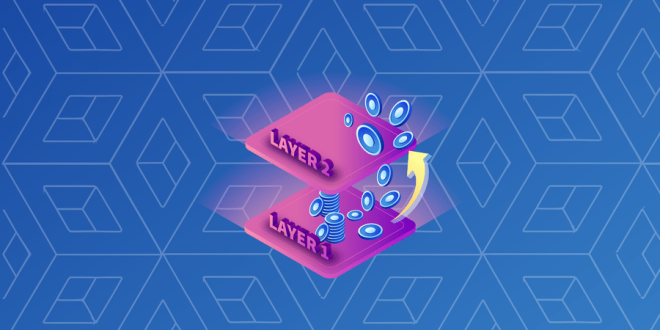Introduction
Blockchain technology has gained immense popularity due to its decentralized and transparent nature. However, as more users and applications join the blockchain network, scalability becomes a pressing concern. Layer 2 scaling solutions provide a way to address this challenge and enable blockchain networks to process a significantly higher number of transactions per second. In this article, we will delve into the world of Layer 2 scaling solutions, exploring their various types, benefits, and implications for the future of blockchain technology.
Understanding Layer 1 and Layer 2
Before we dive into Layer 2 scaling solutions, let’s first understand the difference between Layer 1 and Layer 2 scaling. Layer 1 scaling refers to improving the scalability of the base layer of a blockchain protocol. This involves making changes to the underlying blockchain architecture, such as increasing block sizes or optimizing consensus algorithms. While Layer 1 scaling is essential, it has its limitations.
Layer 2 scaling, on the other hand, is a complementary approach that builds on top of the existing Layer 1 protocols. It aims to alleviate scalability constraints by enabling off-chain processing of transactions while leveraging the security and decentralization of the underlying blockchain. Layer 2 scaling solutions offer a way to achieve higher throughput without compromising on the underlying blockchain’s security or decentralization.
Layer 1 and Layer 2 are two fundamental concepts in blockchain technology. Layer 1 refers to the base layer of a blockchain protocol, which includes the core infrastructure and consensus mechanism. It is responsible for maintaining the blockchain’s security, decentralization, and integrity. However, Layer 1 scalability is often limited, leading to slower transaction speeds and higher fees. Layer 2, on the other hand, is a complementary layer built on top of Layer 1. It aims to address the scalability challenge by enabling off-chain processing of transactions while leveraging the security and decentralization of the underlying Layer 1 blockchain. Layer 2 solutions provide a way to achieve higher throughput without compromising the core principles of blockchain technology.
Different Types of Layer 2 Scaling Solutions
Layer 2 scaling solutions come in various forms, each with its unique characteristics and implementation approaches. Let’s explore some of the most prominent types:
State Channels
State channels are a type of Layer 2 scaling solution that enables off-chain transactions between participants. By opening a state channel, users can conduct multiple transactions without involving the main blockchain for each interaction. Only the final state is recorded on the blockchain, reducing the overall computational load and increasing transaction throughput. State channels are particularly useful for applications requiring frequent interactions, such as gaming or microtransactions.
Plasma
Plasma is another Layer 2 scaling solution that introduces hierarchical blockchains, often referred to as child chains or sidechains, connected to the main blockchain. These child chains operate independently, processing a subset of transactions while periodically submitting the final state to the main chain. Plasma offers increased scalability by distributing transaction processing across multiple chains, allowing for a higher number of transactions to be processed in parallel.
Sidechains
Sidechains are independent blockchains that run in parallel to the main blockchain. They enable users to transfer assets from the main chain to the sidechain, where transactions can be processed with higher throughput and lower fees. Sidechains maintain their consensus mechanisms and security models, providing an additional layer of scalability and flexibility to the overall blockchain ecosystem.
Rollups
Rollups are Layer 2 solutions that bundle multiple transactions together and submit them as a single batch to the main blockchain. By aggregating transactions, rollups significantly reduce the computational overhead required for processing each transaction on the main chain. This approach allows for higher scalability while maintaining the security guarantees of the underlying blockchain.

Comparison of Layer 2 Scaling Solutions
When considering Layer 2 scaling solutions, several factors come into play. Performance and scalability are key considerations, as the goal is to achieve higher transaction throughput and lower fees. Security and trust assumptions are crucial, as Layer 2 solutions introduce additional components and mechanisms that must be carefully designed to ensure the integrity of the system. Development and adoption considerations also play a role, as the availability of robust developer tools and community support can significantly impact the adoption of Layer 2 solutions.
Implementations and Projects
When it comes to Layer 2 scaling solutions, there are several notable implementations that have been successfully deployed or are currently in active development. These solutions showcase the innovation and progress being made in addressing blockchain scalability challenges. Here are some notable examples:
- Optimistic Rollups: Optimistic Rollups have gained significant attention as a Layer 2 scaling solution. They operate by bundling multiple transactions together and submitting them as a single batch to the main blockchain. By doing so, Optimistic Rollups reduce the computational load on the main chain, resulting in increased scalability. Ethereum’s Optimism and Arbitrum are two well-known implementations of Optimistic Rollups, both offering enhanced transaction throughput and lower fees.
- zkRollups: zkRollups, short for zero-knowledge rollups, leverage zero-knowledge proofs to achieve scalability while maintaining strong security guarantees. These Layer 2 solutions bundle multiple transactions together and generate a succinct proof that can be verified on the main blockchain. This approach significantly reduces the amount of data that needs to be processed on the main chain, leading to improved scalability. Loopring and StarkWare are prominent examples of zkRollup implementations, providing scalability solutions for decentralized exchanges and other applications.
- Polygon (formerly Matic Network): Polygon is an Ethereum scaling framework that offers multiple Layer 2 solutions. It provides a range of scaling options, including Plasma, zkRollups, and optimistic rollups, allowing developers to choose the most suitable solution for their specific use cases. Polygon has gained significant popularity due to its ease of integration and compatibility with existing Ethereum infrastructure. It enables faster and cheaper transactions while maintaining a high level of security.
- Optimism: Optimism is a Layer 2 scaling solution specifically designed for Ethereum. It utilizes Optimistic Rollups to achieve scalability by processing transactions off-chain and periodically submitting the final state to the Ethereum mainnet. Optimism provides an environment where developers can seamlessly deploy and interact with decentralized applications while benefiting from increased transaction throughput and reduced fees. Several projects, including Uniswap and Synthetix, have already deployed on the Optimism network.
- Hermez Network: Hermez Network is a decentralized zkRollup designed to improve scalability on Ethereum. By aggregating transactions off-chain and generating zero-knowledge proofs, Hermez achieves high transaction throughput and low fees while maintaining the security and decentralization of the Ethereum network. It focuses on enabling efficient token transfers and provides a bridge between Layer 1 and Layer 2 solutions, offering a seamless user experience.
These examples highlight the progress being made in the development of Layer 2 scaling solutions. As blockchain technology continues to evolve, these implementations play a crucial role in enhancing scalability and opening up new possibilities for decentralized applications.
Challenges and Limitations
While Layer 2 scaling solutions offer promising avenues for scaling blockchain networks, they also face certain challenges and limitations. Regulatory concerns surrounding off-chain transactions and the need for interoperability between different Layer 2 solutions are significant hurdles to overcome. Additionally, ensuring a seamless user experience and widespread adoption of Layer 2 solutions require continuous innovation and education within the blockchain community.
Future Outlook and Impact
Looking ahead, Layer 2 scaling solutions have the potential to revolutionize blockchain technology. By significantly improving scalability while maintaining security and decentralization, Layer 2 solutions can enable the mass adoption of decentralized applications and enhance the overall user experience. As the technology matures and more projects embrace Layer 2 solutions, we can expect a transformative impact on various industries that rely on blockchain technology.
Conclusion
Layer 2 scaling solutions play a vital role in addressing the scalability challenges faced by blockchain networks. By leveraging off-chain processing and innovative mechanisms, Layer 2 solutions enable higher transaction throughput without compromising on security or decentralization. The diverse range of Layer 2 solutions available, such as state channels, plasma, sidechains, and rollups, provide flexibility and scalability options for different use cases. As the blockchain ecosystem continues to evolve, exploring and adopting Layer 2 scaling solutions will be key to unlocking the full potential of blockchain technology.
FAQs
- What are Layer 2 scaling solutions? Layer 2 scaling solutions are complementary approaches built on top of Layer 1 blockchain protocols that aim to enhance scalability by enabling off-chain transaction processing.
- How do Layer 2 solutions improve blockchain scalability? Layer 2 solutions improve scalability by reducing the computational load on the main blockchain through off-chain processing, bundling transactions, or introducing sidechains.
- Are Layer 2 solutions secure? Layer 2 solutions introduce additional components and mechanisms, which must be designed with security in mind. While security risks exist, proper implementation and careful design can ensure the integrity of the system.
- Which Layer 2 solution is the best? The best Layer 2 solution depends on the specific requirements of the use case. Each solution has its own advantages and trade-offs, so it’s important to evaluate them based on performance, security, and adoption considerations.
- How can Layer 2 solutions benefit decentralized applications? Layer 2 solutions can significantly enhance decentralized applications by increasing transaction throughput, reducing fees, and improving overall user experience, thereby enabling widespread adoption and scalability.

I’m a highly experienced and successful crypto author who has helped thousands of people to invest in cryptocurrencies. I have a good knowledge and experience in the industry, and I have always been up-to-date with the latest developments. I’m a highly respected member of the crypto community, so if you are looking for someone to help you navigate the world of cryptocurrencies, then you can always contact me.
 Crypto Print
Crypto Print

